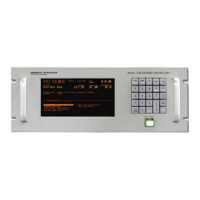Overview
The standard main input voltage for the drive cabinet is either 208 VAC three-
phase WYE, or 380 - 415 VAC three-phase WYE requiring a four-wire circuit plus a
ground conductor. The actual current/power requirements for a given system are
essentially established by the drive motor characteristics with only a small portion
being used for control logic power. Other input voltages and frequencies are
available as options, as is single-phase input power (the drive motors remain three-
phase in this case as the inverter modules perform the required conversion). The
input power wiring connects to pressure-type lug terminals on the main circuit
breaker housing inside the drive cabinet.
NOTE: In all cases, power wiring to the drive cabinet
must be sized for the rated currents and voltage drop and installed
by qualified personnel in accordance with local codes.
Power for each of the drive motors is supplied from the drive cabinet through
double insulated cables which are run through conduit and other enclosures serving
as cable plenums and pull boxes. The motor power conductors connect to
pressure-type lugs on terminals in the drive cabinet and in the motor junction
boxes. Motor power wiring is sized for rated currents and voltage drops and is
protected by overcurrent devices as defined by the regulations of the National
Electrical Code (NEC), International Electrotechnical Commission (IEC), and
Institute of Electrical and Electronic Engineers (IEEE).
Overtravel limit switches for each axis are interfaced with the drive cabinet via
double insulated control cabling. In the drive cabinet, drive interlock logic is
provided for each direction of travel and a summary limit alarm is developed and
provided to the ACU for display. The limit switch cables connect to pressure-type
terminals at each limit switch and in the drive cabinet.
Axis drive commands and drive cabinet status signals are passed between the ACU
and drive cabinet through a 25 conductor, #22 AWG cable with a maximum length
of 1500 feet. The cable connects to a pressure-type terminal strip in the drive
cabinet and terminates into a 25-pin female D-connector at the rear of the ACU.
The AZ, EL, and POL (three-axis systems) and AZ, EL, POL and 4TH AXIS (four-
axis systems) transducers interface directly with the ACU via a shielded
multiconductor cable for each device. The standard configuration includes single-
speed, brushless resolvers that require three twisted pair cables. The cables
terminate to flying leads at the resolver via solder or positive crimp connections
and terminate into male D-connectors at the ACU end (25-pin for AZ and EL; 9-pin
for POL). Other types of position transducers, including high accuracy two-speed
resolvers and absolute optical encoders, are available as options to accommodate
critical antenna pointing accuracy requirements or to provide additional resolution
for narrow beamwidths.
2-4

